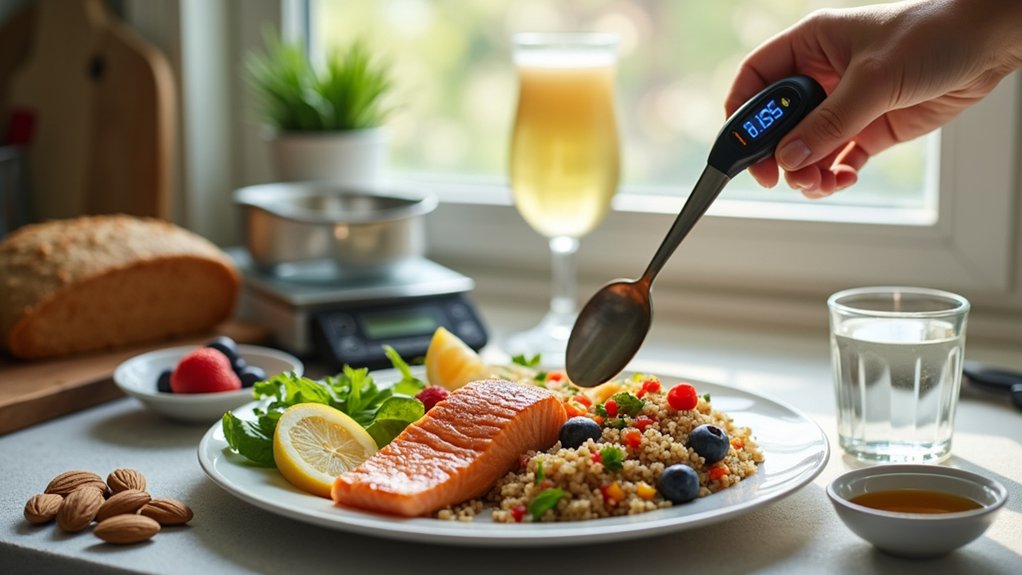
What are the weight loss injections side effects?
Many weight loss injections promise quick results, but their side effects may surprise you and affect more than just your waistline. Discover the truth.


Managing diabetes often starts in the kitchen. If you’re wondering what nutritional tips help manage diabetes effectively, focus on low-glycemic, high-fiber carbohydrates paired with lean proteins and healthy fats to support stable blood sugar and better energy. Portion control and the plate method simplify choices, while consistent meal timing helps reduce spikes and crashes—key strategies when considering what nutritional tips help manage diabetes effectively. Whole foods beat ultra-processed options, hydration supports appetite and glucose control, and smart label reading helps you avoid hidden sugars. For fitness and wellbeing, tailor carbs around activity, prioritize protein at each meal, and include non-starchy veggies for volume. Work with a registered dietitian to personalize these steps—because what nutritional tips help manage diabetes effectively can vary by your goals, medication, and workout routine.

Although carbohydrates are often viewed with caution in diabetes, selecting low-glycemic, high-fiber options helps stabilize post-meal blood glucose and improve satiety.
Emphasis falls on intact grains, legumes, lentils, beans, steel-cut oats, barley, quinoa, and non-starchy vegetables. Choosing whole fruit over juice, reading labels for ≥4–5 grams fiber per serving, and swapping refined grains for whole-grain alternatives lower glycemic impact.
Gradual fiber increases minimize gastrointestinal discomfort.
Building on the focus on low-glycemic, high-fiber carbohydrates, balanced meals pair these carbs with lean protein and unsaturated fats to blunt glucose spikes, extend satiety, and support weight management.
Practical pairings include salmon with quinoa and vegetables; lentils with olive oil–dressed greens; Greek yogurt with berries and nuts.
Emphasizing omega-3s, plant proteins, and minimally processed fats supports cardiovascular health, preserves muscle, and stabilizes postprandial glucose.
How can portion awareness turn good choices into better glucose control? It helps limit carbohydrate load and prevents calorie creep.
The plate method offers structure: fill half the plate with non-starchy vegetables, one quarter with lean protein, and one quarter with high-fiber carbohydrates.
Use smaller plates, measure servings, and read labels. Choose whole foods over ultra-processed items.
Track portions consistently to reinforce habits and stabilize day-to-day glucose.
Rhythm matters for glucose stability: spacing meals and snacks at predictable intervals helps prevent sharp rises and dips in blood sugar.
Consistent timing trains insulin needs and reduces reactive eating. Many do well with three balanced meals and one to two planned snacks, roughly 3–4 hours apart.
Aligning intake with medication or insulin action curves, activity, and sleep supports steadier readings.
Set reminders and adjust timing during travel or illness.
Many with diabetes benefit from prioritizing minimally processed, fiber-rich foods that slow glucose absorption.
Emphasizing vegetables, legumes, intact whole grains, nuts, seeds, and whole fruits supports steadier postprandial responses and satiety.
Choosing lean proteins and healthy fats from fish, poultry, tofu, and olive oil aids glycemic control.
Limiting ultra-processed snacks and ready meals reduces additives, sodium, and caloric density, helping maintain weight and cardiometabolic health.
Although total carbohydrate matters, careful attention to added sugars and refined grains is pivotal for glycemic stability.
He or she benefits from scanning labels for sucrose, high-fructose corn syrup, syrups, and maltodextrin; limiting desserts, sweetened beverages, and candy; and minimizing white bread, regular pasta, and many breakfast cereals.
Emphasizing minimally sweetened foods and choosing slower-digesting starches supports steadier post-meal glucose, reduced insulin demand, fewer cravings, and improved energy consistency.
Because fiber blunts glucose rises and improves satiety, prioritizing vegetables, legumes, and whole grains is a cornerstone of diabetes nutrition.
Non-starchy vegetables, lentils, chickpeas, beans, oats, barley, and intact whole grains slow carbohydrate absorption and support stable postprandial glucose.
Emphasizing minimally processed options, gradual increases in fiber, and pairing fiber with protein and healthy fats enhances glycemic control, supports weight management, and promotes favorable lipid profiles.
Why does hydration matter so much for glycemic stability? Adequate fluid intake supports kidney glucose excretion, helps prevent dehydration-related hyperglycemia, and may reduce appetite misinterpreted as thirst.
Water, unsweetened tea, or black coffee are prudent choices. Sugary beverages rapidly spike blood glucose and add excess calories.
Limit fruit juice and sweetened drinks; consider sparkling water with citrus. Monitor caffeine tolerance and alcohol mixers, favoring sugar-free options.
Planning meals and scrutinizing labels equips individuals with diabetes to control carbohydrate intake, avoid hidden sugars, and balance calories across the day.
A grocery list based on fiber-rich vegetables, lean proteins, and whole grains streamlines choices. Reading serving sizes, total carbohydrates, added sugars, and sodium prevents surprises.
Comparing brands for lower carbs and higher fiber helps glycemic control. Batch-cooking and portioning reduce impulsive eating.
Although general guidelines are useful, tailoring nutrition to medical history, lab results, medications, and cultural preferences yields better glycemic control and sustainability.
A registered dietitian or certified diabetes care and education specialist can calibrate carbohydrate targets, fiber goals, meal timing, and insulin-to-carb ratios.
They refine hydration, sodium, and alcohol advice, troubleshoot hypoglycemia, address weight goals, and integrate CGM data, while respecting budget, food access, and cultural traditions.
In summary, effective diabetes nutrition centers on steady blood sugar through smart choices and consistency. Emphasizing low-glycemic, high-fiber carbohydrates, balanced plates with lean proteins and healthy fats, and mindful portions supports stability. Regular meal timing, hydration, and limiting sugary drinks reduce spikes. Opting for minimally processed foods, planning ahead, and reading labels add control. Prioritizing fiber from vegetables, legumes, and whole grains enhances satiety and glucose response. Personalized guidance ensures the plan fits lifestyle, preferences, and medical needs.

Many weight loss injections promise quick results, but their side effects may surprise you and affect more than just your waistline. Discover the truth.

Achieve your weight loss goals with these 4 delicious smoothie recipes that boost metabolism and curb cravings—discover how tasty health can be.

Fast weight loss can lead to surprising side effects that affect your body and health in unexpected ways; discover what you need to know before starting.

Micronutrients and macronutrients matter immensely for health, but do you know how they differ and why both are essential? Discover the key facts inside.

It’s incredible how water impacts every part of your body—discover why drinking it daily is essential for your health and vitality.

Kiwis, kale, and other surprising foods pack both vitamin C and zinc—discover which four powerhouses boost immunity like you never knew.